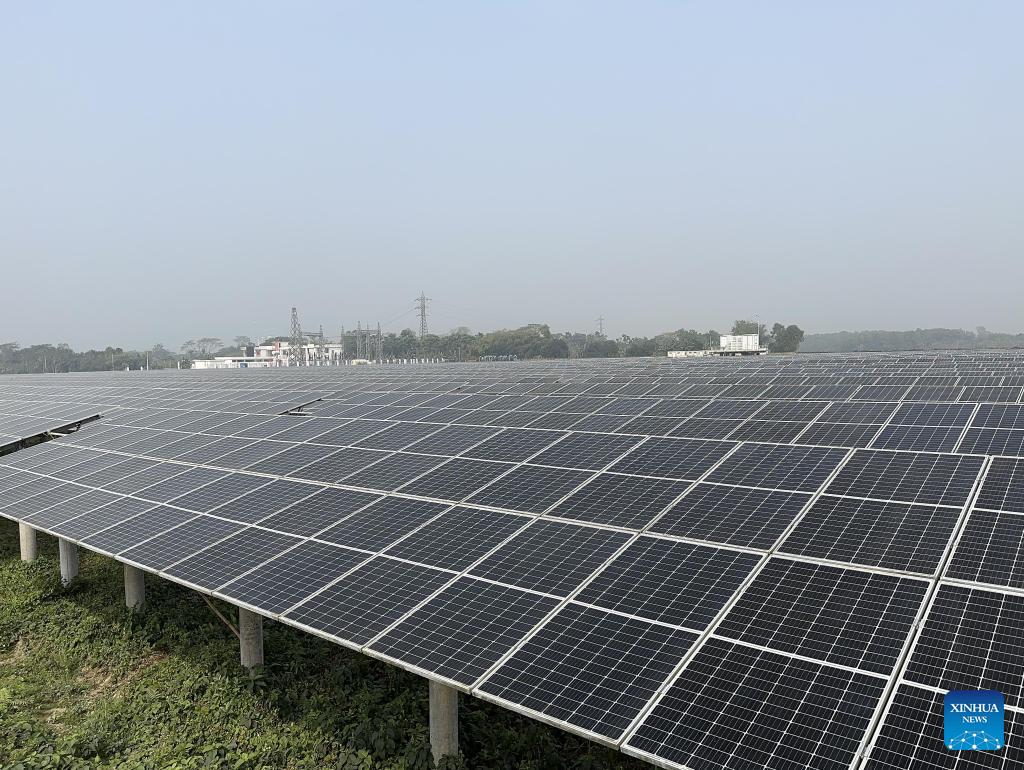
 0 Comment(s)
0 Comment(s) Print
Print E-mail China Daily, April 30, 2024
E-mail China Daily, April 30, 2024

This photo taken on Feb. 17, 2024 shows a 50 MW Chinese-built photovoltaic power plant in Mymensingh District, Bangladesh. [Photo/Xinhua]
China's large-scale development of solar power, coupled with continuous innovation and a complete industrial chain, is driving down production costs and making new energy products more affordable worldwide, experts said.
This shift benefits the global community, whose current solar capacity still falls short of quantities needed to achieve decarbonization goals. Developing nations in particular require more advanced solar capacity to make electricity more accessible and cost-effective for both households and businesses, they said.
The remarks came after some Western politicians and media outlets recently claimed that China is creating excess capacity within the new energy sector and causing market distortions abroad by dumping products at low prices, thus damaging other economies.
"Concerns have been heightened in Western nations given the rapid growth of China's solar industry, which epitomizes the swift evolution of the country's new energy sectors. The advancement of China's solar industry plays a pivotal role in ensuring a stable supply of solar products to address climate change worldwide, making solar power one of the most economical power sources for the vast majority of countries and regions globally," said Liu Yiyang, deputy secretary-general of the China Photovoltaic Industry Association, a trade body.
Liu said that current solar capacity still falls short of global market demand, particularly given the substantial demand for power in numerous developing nations.
At a warehouse in Uzbekistan, Chinese solar panels are set to energize and provide affordable clean energy for refugees across Asia, guided by the UN Refugee Agency and Chinese solar firm LONGi.
Raouf Mazou, the agency's assistant high commissioner for operations, said that Chinese energy firms empower the agency to expand its reach and impact in addressing climate issues and achieve energy equity for vulnerable populations globally.
"China's abundant resources, innovative technology and extensive global relationships could make significant contributions to our work. We look forward to more fruitful collaborations with Chinese authorities and companies in addressing challenges linked to displacements arising from climate change," Mazou said.
Over 100 countries reached agreements at the COP28 climate change conference late last year to ensure that global renewable energy capacity triples to over 11,000 gigawatts by 2030, with cumulative photovoltaic capacity rising to about 5,457 GW by then.
According to data compiler Statista, in 2022, cumulative global solar PV capacity stood at some 1,177 GW, falling short of the goal.
"Some politicians' criticism that China's excess solar capacity is leading to low costs and impacting global industrial competition is untenable. This rhetoric aims to curb China's industrial development, and will have adverse effects on global green transformation. China's scaled development, supply chain construction and technological iteration in the global PV industry have led to rapid cost reductions, allowing more countries — especially developing ones — to enjoy affordable electricity, promoting local economic development and bridging disparities among regions," said Lin Boqiang, head of the China Institute for Studies in Energy Policy at Xiamen University.
"Chinese enterprises have also promoted global development of the PV industry through international cooperation and overseas factories, facilitating other countries' green transformation of their energy structures. Whether it be the United States or elsewhere, without competitively priced products from China, it's hard to imagine whether the current international confidence in addressing climate change would remain as strong," Liu said.
Taking Europe as an example, a report by the International Energy Agency showed that, from 2021 to 2023, new installations of photovoltaic and wind power were estimated to have saved approximately 100 billion euros ($107 billion) for electricity consumers in the European Union.
The CPIA estimates that without new wind and solar installations, the average wholesale electricity price in the EU would have been 8 percent higher in 2022.
"The rapid development of China's PV industry holds profound significance for many developing countries. It provides a means for developing countries to overcome energy shortages in a cost-effective manner and reduce reliance on imported fossil fuels," Liu said.